72 F. maximum temperature yesterday in the Twin Cities.
70 F. average high on May 17.
65 F. high on May 17, 2016.
May 18, 1980:
Mt. St. Helens erupts. The smoke plume eventually rises to 80,000 feet,
circling the earth in 19 days. Brilliant sunsets due to the smoke are
seen over Minnesota for days afterward.
May 18, 1933: Tornadoes hit McLeod and Mower counties.
Tornado Shelters, Heat Bursts and Muddy ShowersIn light of the deadly Chetek, Wisconsin tornado I reviewed
Minnesota's regulations.
Manufactured home parks with 10 or more homes, licensed after March 1,
1988, must provide a storm shelter within the park. But parks licensed
prior to March 1, 1988, must provide either a shelter on the premises
-or- evacuation plans to a storm shelter close to the park.
Huh?
"Storm shelters are expensive!" So are brakes, but car manufacturers still include them with every purchase.
When
tornadoes hit these manufactured home parks damage is extensive. 44
percent of the 1,091 Americans killed by tornadoes from 1985 to 2005
died in mobile homes.
Details here.
Tuesday's
rain was muddy, possibly the result of a "heat burst" in southwestern
Minnesota lofting freshly-tilled topsoil into the air, then coming down
during heavy showers. Bizarre.
We dry out later today, but more
showers arrive Friday; heavier rain Saturday. Another 1-2 inches of rain
may fall before skies try to brighten up on Sunday.
Refreshing (?) 50s give way to 60s and 70s next week. Keep an eye out for muddy showers. Never a dull moment, huh?
Drone Footage of Barron County Tornado. This is pretty amazing, courtesy of
YouTube and
Branden Bodendorfer.
"On May 16th, 2017, a tornado ripped through Barron County. Among it's
path was a trailer park, a turkey farm and many residential homes along
the lake."
 Despite Tornado Threat, Shelters Rare for Mobile Home Parks
Despite Tornado Threat, Shelters Rare for Mobile Home Parks. Here's an excerpt of a story at
News OK published back in January which seems even more timely today: "...
According
to the National Weather Service, 44 percent of the 1,091 Americans
killed by tornadoes from 1985 to 2005 died in mobile homes, compared to
25 percent in stick-built homes. That's especially significant
considering how few Americans — 8 percent or fewer — lived in mobile
homes during that period. Over the weekend, an unusual midwinter
outbreak of dozens of tornadoes shredded two mobile home parks that
didn't have shelters in southwest Georgia. Three people were killed at
Big Pine Estates in Albany and seven died at Sunrise Acres in rural Cook
County. For most of the U.S., installing storm shelters remains a
voluntary decision whether they're for a private home, a mobile home
park or a community center. Alabama and Illinois have laws mandating
that new public schools are built with storm shelters, and Minnesota
requires shelters at mobile home parks with spaces for 10 or more homes
built since 1988..."
Tornado Shelters and Minnesota Manufactured Home Parks. I had some questions in light of the Chetek, Wisconsin tornado. What is required in Minnesota? Here's an excerpt from
Minnesota Attorney General Lori Swanson's office: "...
Storm
shelters or evacuation plans provide residents with access to safe
shelter in cases of bad weather. Storm shelter plans vary depending on
the size of a park and when the park was originally licensed. Parks with
fewer than ten homes must provide either a shelter on the premises or a
plan for evacuation to a nearby shelter. The plan or shelter should be
developed with the assistance and approval of the park’s local
municipality. Parks with ten or more homes, licensed prior to March 1,
1988, must provide either a shelter on the premises, or evacuation plans
to a storm shelter close to the park. The shelter or evacuation plan
must have been approved by the park’s local municipality by March 1,
1989, and a copy submitted to the Department of Health. The park owner
must give all residents a copy of the evacuation or shelter plan. Parks
with ten or more homes, licensed after March 1, 1988, must provide a
storm shelter within the park. Shelters constructed after March 1, 1988,
must comply with the state building code. The Department of Labor and
Industry enforces the state’s building code and has jurisdiction over
the proper construction of storm shelters. The Department of Health has
jurisdiction over whether the shelter or shelter plan is adequate to
meet the needs of park residents..."
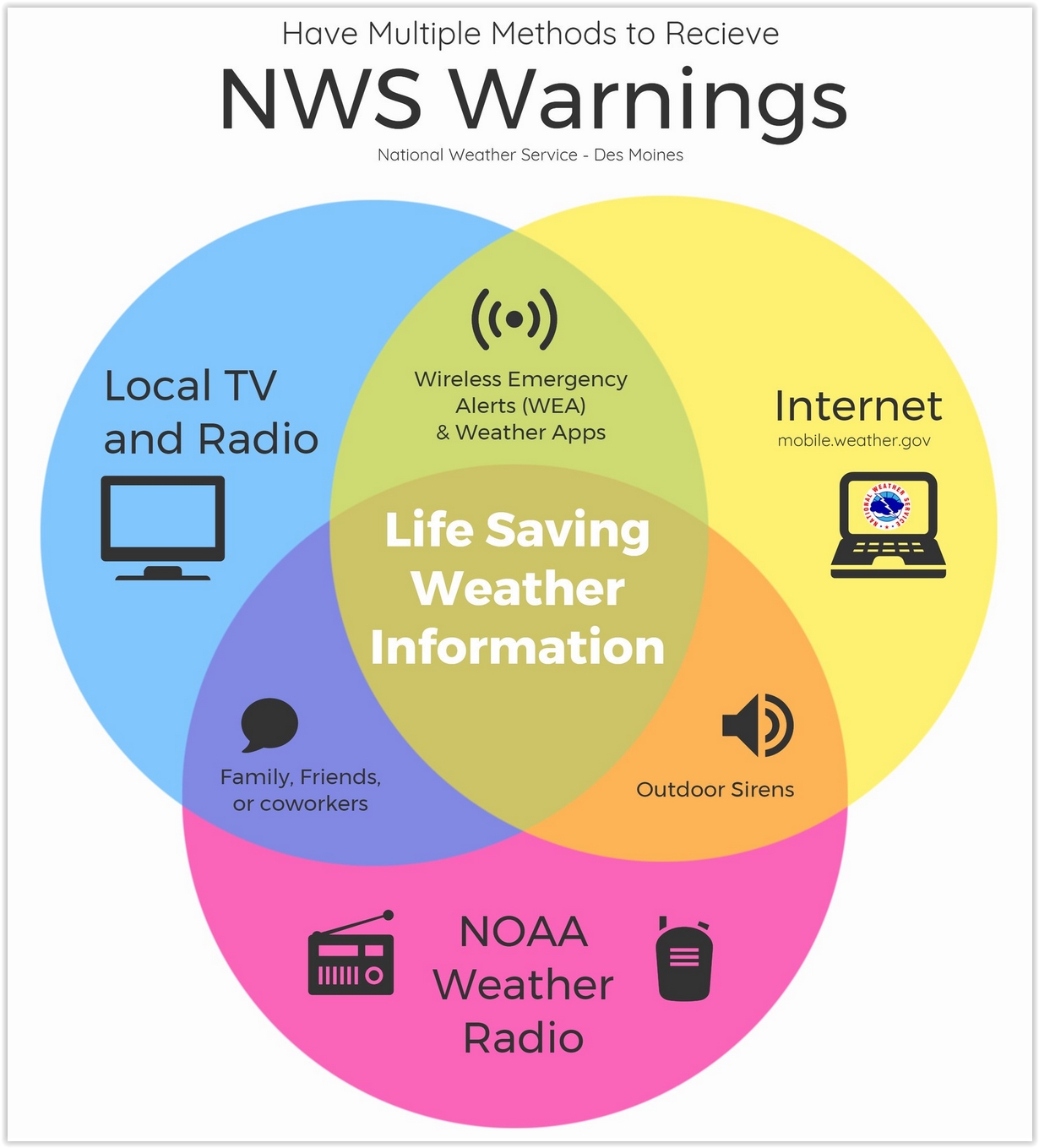
For
most of the U.S., installing storm shelters remains a voluntary
decision whether they're for a private home, a mobile home park or a
community center. Alabama and Illinois have laws mandating that new
public schools are built with storm shelters, and Minnesota requires
shelters at mobile home parks with spaces for 10 or more homes built
since 1988.
 More Details on Elk City, Wisconsin Tornado
More Details on Elk City, Wisconsin Tornado. Here's a clip from a
US News update: "...
The
Red Cross says dozens of people who lost their homes when a tornado
leveled a trailer park in northwestern Wisconsin are staying with
relatives or friends while others are using donated hotel rooms and a
temporary shelter. Red Cross spokesman Luong Huynh (loon ha-when) says
30 to 50 people came through a reception center at Mosaic Telecom in
Cameron after the destructive tornado hit nearby Tuesday. Authorities
say a 46-year-old man was killed and a couple of dozen people were
injured. The severe weather also caused extensive damage to several
turkey barns across from the mobile home park. Mayor Jeff Martin in
nearby Chetek (sheh-TEK') says turkeys can be seen wandering in the
damage..."
Photo credit: "
Part of a
building sits on a vehicle after a tornado ripped through Prairie Lake
Estates trailer home park, just north of Chetek, Wis., Tuesday, May 16,
2017. The tornado swept into the mobile home park in western Wisconsin
on Tuesday, as a storm system also pounded parts of at least seven
states from Texas to near the Canadian border with heavy rain, high
winds and hail." (Dan Reiland/The Eau Claire Leader-Telegram via AP)
The Associated Press.
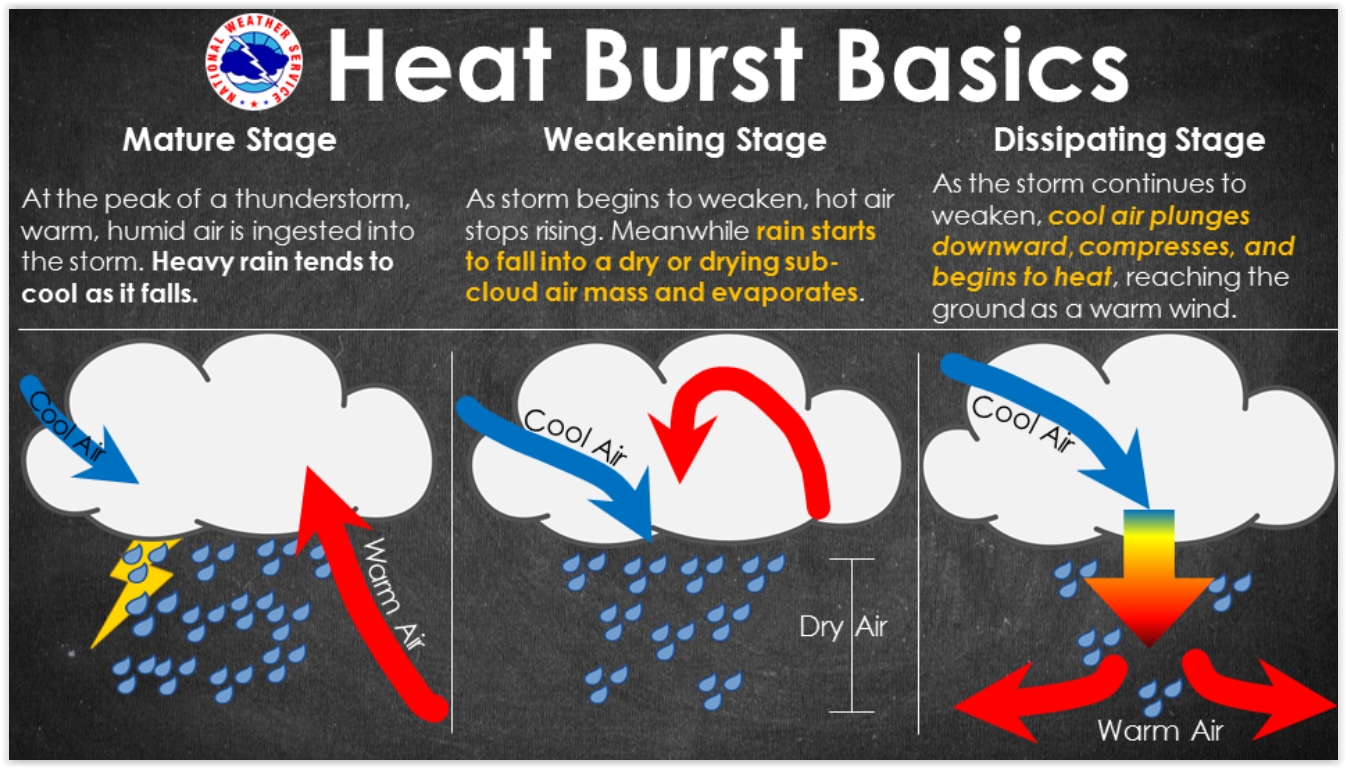 What Causes a Heat Burst? The National Weather Service in Sioux Falls explains the meteorology behind Tuesday morning's storm-driven surge of heat, wind (and dirt): "When
a thunderstorm is mature, warm and moist air rises into the storm. As
the air rises, water drops (and ice crystals) form within the clouds
which then fall out as heavy rain. With heavy rain falling, the air
beneath the cloud is cooled due to evaporation. As a result, the air at
the surface is typically cooler than the warm and moist air ahead of the
thunderstorm. As the thunderstorm weakens, rainfall decreases. In most
cases, when there is warm and moist air in the lowest 5000 feet of the
atmosphere, the wind will decrease as the storm weakens and rain no
longer reaches the surface. However, when there is very dry air below
the cloud base, as occurred last night (see below), then evaporation
continues below the cloud base. Where rain is evaporating, the colder
air, which is denser than the air around it, will continue to accelerate
toward the surface. Once the rain completely evaporates, the air will
begin to warm more quickly as it approaches the surface. As it reaches
the surface, the air is actually warmer and drier than the air ahead the
storm
What Causes a Heat Burst? The National Weather Service in Sioux Falls explains the meteorology behind Tuesday morning's storm-driven surge of heat, wind (and dirt): "When
a thunderstorm is mature, warm and moist air rises into the storm. As
the air rises, water drops (and ice crystals) form within the clouds
which then fall out as heavy rain. With heavy rain falling, the air
beneath the cloud is cooled due to evaporation. As a result, the air at
the surface is typically cooler than the warm and moist air ahead of the
thunderstorm. As the thunderstorm weakens, rainfall decreases. In most
cases, when there is warm and moist air in the lowest 5000 feet of the
atmosphere, the wind will decrease as the storm weakens and rain no
longer reaches the surface. However, when there is very dry air below
the cloud base, as occurred last night (see below), then evaporation
continues below the cloud base. Where rain is evaporating, the colder
air, which is denser than the air around it, will continue to accelerate
toward the surface. Once the rain completely evaporates, the air will
begin to warm more quickly as it approaches the surface. As it reaches
the surface, the air is actually warmer and drier than the air ahead the
storm."
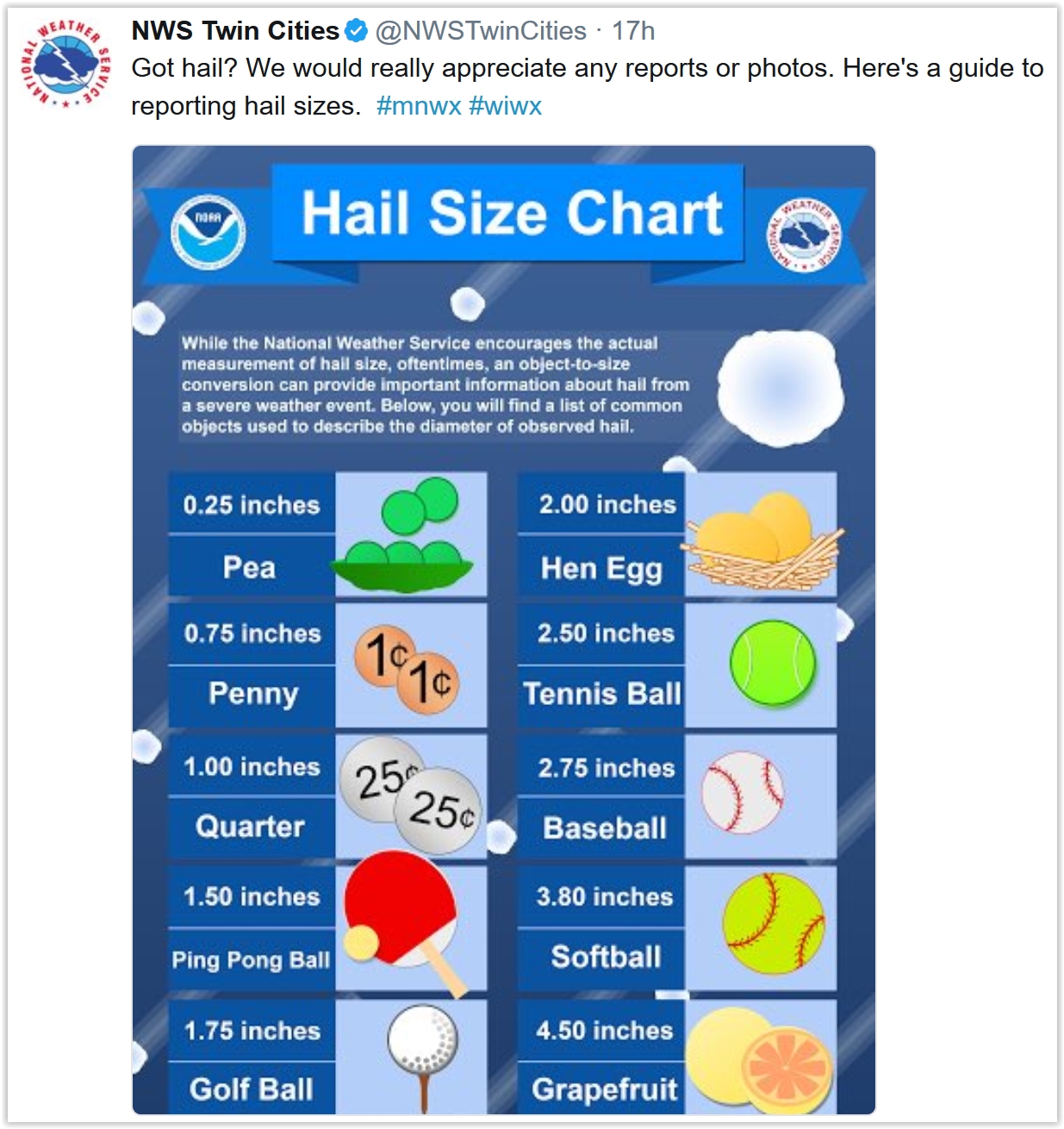
 Praedictix Briefing
Praedictix Briefing: Issued Wednesday, May 17
th, 2017
- The Storm Prediction Center has issued a Moderate Risk of severe weather for tomorrow (Thursday)
across parts of the Southern Plains, including Kansas and Oklahoma.
This threat includes the cities of Dodge City and Great Bend (KS) as
well as Woodward and Clinton (OK).
- As a system pushes into the
Plains, we will be watching the threat of tornadoes (some of which could
be strong), very large hail and damaging winds tomorrow afternoon and evening across the region.
Moderate Risk Thursday.
A Moderate Risk of severe weather has been put in place by the Storm
Prediction Center for Thursday across parts of northwest Oklahoma and
southwest Kansas. This Moderate Risk area includes the cities of Dodge
City and Great Bend (KS) as well as Woodward and Clinton (OK). This is
due to a system that will be pushing into the central U.S. during the
day, which will help spark off strong to severe storms capable of
tornadoes (some of which could be strong), very large hail and damaging
winds
tomorrow
afternoon and evening across the region. The surrounding Enhanced Risk
area includes the cities of Oklahoma City (OK), Wichita (KS), and
Wichita Falls (TX).
Storm Timing. Storms will quickly develop across the region during the mid/late afternoon hours
Thursday,
with the potential of very large hail and tornadoes (some potentially
strong). As we go through the evening, storms will merge into more
linear lines as they race eastward, increasing the threat for damaging
winds across Kansas and Oklahoma into the overnight hours.
Summary. A Moderate Risk of severe weather has been put in place across parts of Oklahoma and Kansas for
Thursday,
including Dodge City (KS) and Woodward (OK). We will be watching the
threat of severe weather during the afternoon and evening hours
tomorrow across this area, possibly containing tornadoes (some strong), very large hail and damaging winds.
D.J. Kayser, Meteorologist, Praedictix
Beware of Electrical "Bolts From The Blue"
In my quest to know any (future) grandkids I have a healthy respect for
lightning. The first growl of thunder I duck into a building or
vehicle. 38 Americans were killed by lightning in 2016, almost all these
deaths ultimately preventable. I've run into coaches who don't move
kids to safety until they can "see the lightning". Which is just asking
for trouble. Because lightning can travel up to 10 miles, horizontally.
People have been struck and killed with blue sky directly overhead, a
distant thunderhead on the horizon. There's a reason why the expression
"bolt from the blue" exists.
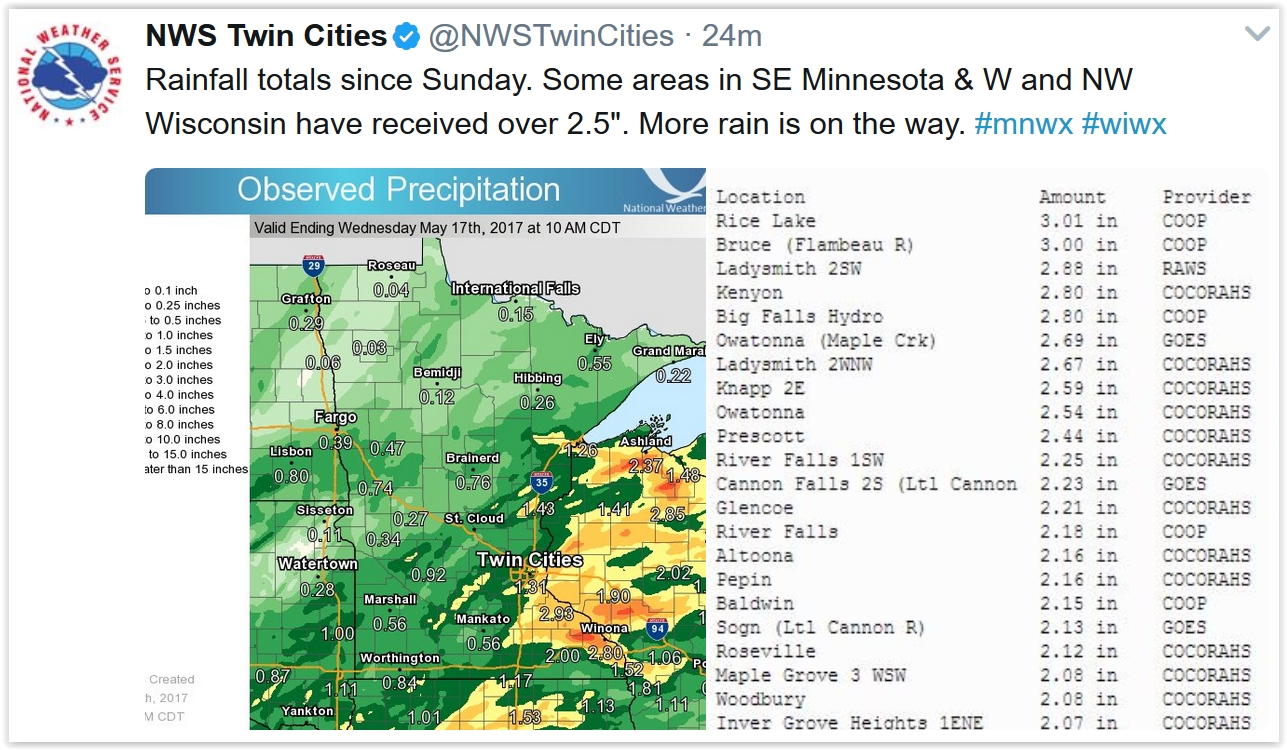

Jackets Return into Sunday - Then Warming Up.
ECMWF guidance keeps us 10-15F cooler than average into the weekend,
before temperatures mellow a bit next week. Source: WeatherBell.
Blocking Tendencies.
What I'd give for a week or two of zonal flow right about now. The
2-week GFS forecast for 500 mb suggests a cut-off low for the eastern
half of the USA, which (if it verifies) would suggest cooler, showery
weather east of the Mississippi with warm sunshine for much of the
western United States.
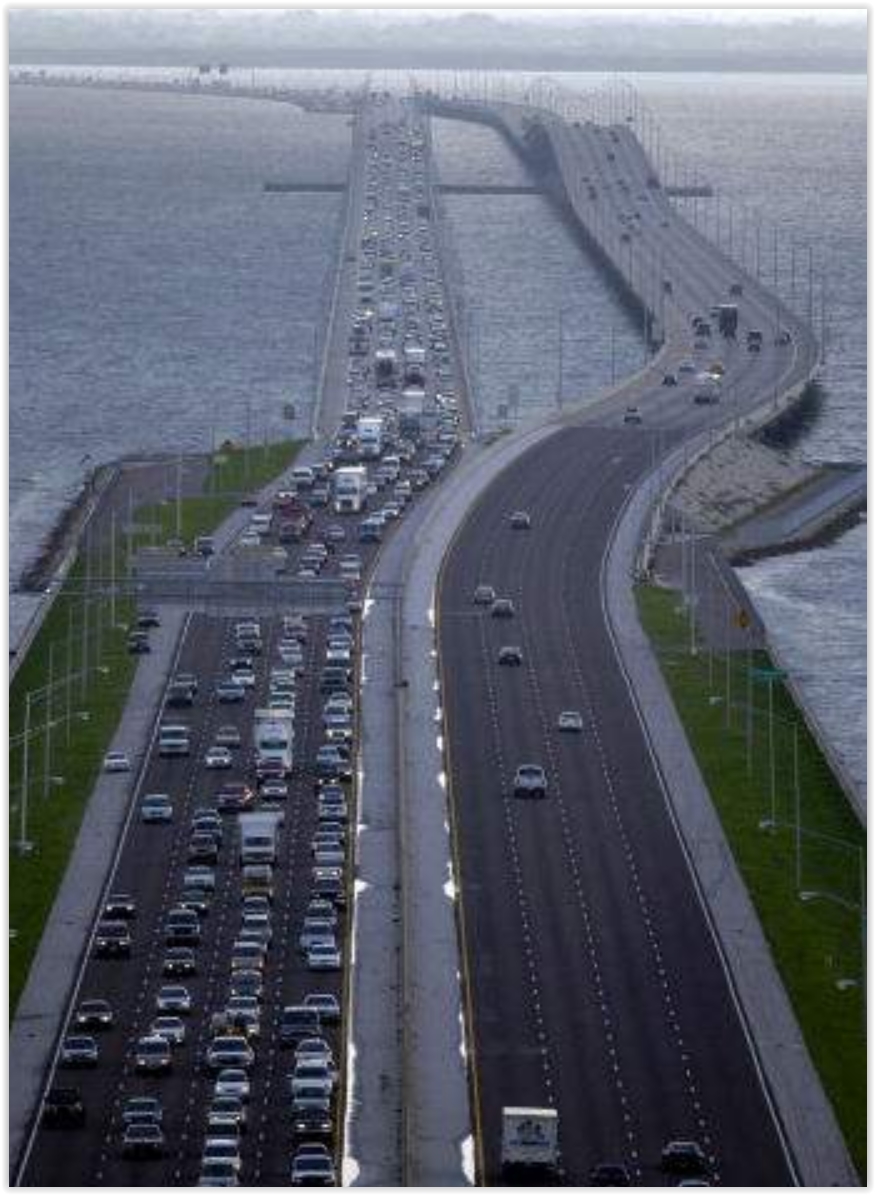 Just Imagine: 1.5 Million in Evacuation Gridlock as a Hurricane Aims at Tampa Bay.
Just Imagine: 1.5 Million in Evacuation Gridlock as a Hurricane Aims at Tampa Bay.
The west coast of Florida has been (supernaturally) lucky in recent
decades. Pondering a worst-case scenario for the Tampa area gives
emergency planners the chills, explains
TBO.com: "...
Nearly
every scenario seems nightmarish: In Pinellas County, a Level D
evacuation gives 585,000 people — half the county's population — 36
hours to crawl across the Courtney Campbell Causeway, Howard Frankland
and Gandy bridges. In Pasco County, a Level B evacuation means nearly
175,000 people would have 24 hours to flee east along just two roads,
State Roads 52 and 54. And if a monster hurricane takes aim at the bay
area, the highest evacuation level in Hillsborough, Pasco, Pinellas and
Manatee counties would result in a total of 1.5 million — half the
region — ordered to leave their homes over two full days. The Tampa Bay
area has a booming population but a busted road network. Emergency
management officials wonder how a region that can't handle rush-hour
traffic will deal with the realities of a major hurricane evacuation.
The bay area hasn't had a direct hurricane strike in nearly a century
and hasn't had a major evacuation in more than a decade..."
Photo credit: "
Vehicles
pack the northbound lanes of the Howard Frankland Bridge heading toward
Tampa during the evacuation for powerful Hurricane Charley on Aug. 12,
2004." Times (2004)
Kentucky Town Turning Devastation into Innovation. Some tornadoes have silver linings. Here's an excerpt from
Proud Green Building: "..
.Clark has been a part of the post-disaster recovery in West Liberty that was modeled after Greensburg.
"Destroyed by an EF-5 tornado, only three buildings remained after this
tornado and the community decided to build back a green sustainable
community. They got a wind farm, they had to build everything from
schools to government and homes in the community," Clark said.
Greensburg rebuilt its community with green building construction,
using 100 percent renewable energy and using wind farms to keep the
lights on. In West Liberty, that same goal was made part of its master
plan to a degree..."
Photo credit: WKYT-TV.
Insurance Know-How Can Help Cities Cut Disaster Risk: U.N. Expert. A few statistics in a
Reuters story made me do a double-take: "...
The
number of disasters affecting cities is expected to rise amid climate
change and rapid urbanization, particularly in Africa and Asia, which
will see the share of the global population living in urban areas rise
to two-thirds from just over half at present. Globally,
80 percent of the largest cities are vulnerable to severe earthquakes,
and 60 percent are at risk from tsunamis and storm surges, according to U.N. data.
Bacani said insurers can help cities cut their risk, for example, by
improving land-use planning and building codes, and by rewarding
disaster preparedness through their premiums.
"Linking risk reduction efforts to premiums and insurance coverage is
critical to changing behavior and promoting good risk management in
urban areas," he said..."
Estimating Wildfire Fire Risk With a New Tool.
NOAA NCEI explains how the new system works: "...
So, NCEI and the NASA DEVELOP National Program collaborated with the U.S. Army Corps of Engineers (link is external), the Bureau of Indian Affairs, and the South Dakota State Fire Meteorologist (link is external)
to create a Fire Risk Estimation or FIRE tool that automatically
processes satellite and weather station data—including temperature,
precipitation, relative humidity, and wind observations—into a single
measurement of fire potential. To create the FIRE tool, the team began
with a list of indicators used to assess wildfire risk and the
thresholds for each that would indicate higher risk. Provided by fire
managers in South Dakota, these initial indicators and thresholds were
based on meteorological conditions that accompanied several large,
complex wildfires in the past decade..."
U.S. Billion Dollar Weather and Climate Disasters 1980-2017.
Over a trillion dollars in weather and climate-related disasters since
1980. So far we've seen 5 confirmed billion dollar events, but I suspect
Missouri/Arkansas flooding and the recent Denver hailstorm will also
qualify as billion dollar disasters, bringing the subtotal up to 7 so
far this year. All of 2016 brought 15 separate billion dollar weather
and climate disasters to the United States. Details from
NOAA NCEI: "
The
U.S. has sustained 2018 weather and climate disasters since 1980 in
which overall damages/costs reached or exceeded $1 billion. Values in
parentheses represent the 2017 Consumer Price Index (CPI cost adjusted
value (if different than original value). The total cost of these 208
events exceed $1.1 trillion."
The Great American Eclipse is 100 Days Away, and Scientists are Ready.
The Hartford Courant has a good overview: "
This
summer, darkness will fall across the face of America. Birds will stop
singing. Temperatures will drop. Stars will become visible in the
daytime sky. In about 100 days, a total solar eclipse will sweep across
the continental United States for the first time since 1918. Astronomers
are calling it the Great American Eclipse. For the amateur sky-watcher,
a total eclipse presents a rare opportunity to witness a cosmic hiccup
in our day-night cycle. For solar astronomers, however, the eclipse
offers something else: three minutes (give or take) to collect as much
data as possible about the sun’s usually hidden outer atmosphere.
Researchers have been anticipating the event for years..."
Photo credit: "
Williams
College astronomer Jay Pasachoff prepares for a solar eclipse in
Argentine Patagonia in February. He plans to observe this summer's total
eclipse from western Oregon." (Photo courtesy of Jay Pasachoff).
Germany Just Broke a Renewable Energy Record. Here's an excerpt from
indy100: "
The
future came early on Easter Day in Germany, as green energy ran almost
the entire country. On April 30, 64 per cent of electricity consumed in
Germany came from renewable sources, such as wind power and solar. At
2pm, the share of renewables was 85 per cent and between 10am and 6pm
over three quarters of demand was covered by clean energy - an
impressive feat in a world still dominated by coal and oil. German
think-tank Agora Energiewende shared the data of this momentous
achievement, remarking that this sort of situation will be "completely
normal" by 2030. Easter weekend in Germany also saw the the least amount
of coal the country has used “in recent history” and nuclear power
plants reduce their output by up to 40 per cent..."
Photo credit:
Inhabitat.com.
Apple's New Campus: A Look Inside the Mothership. The statistics are mind-boggling. Here's an excerpt of a story at WIRED.com: "...They
describe the level of attention devoted to every detail, the
willingness to search the earth for the right materials, and the
obstacles overcome to achieve perfection, all of which would make sense
for an actual Apple consumer product, where production expenses could be
amortized over millions of units. But the Ring is a
2.8-million-square-foot one-off, eight years in the making and with a
customer base of 12,000. How can anyone justify this spectacular effort?
“It’s frustrating to talk about this building in terms of absurd, large
numbers,” Ive says. “It makes for an impressive statistic, but you
don’t live in an impressive statistic. While it is a technical marvel to
make glass at this scale, that’s not the achievement. The achievement
is to make a building where so many people can connect and collaborate
and walk and talk.” The value, he argues, is not what went into the
building. It’s what will come out..."
Photo credit: Dan Winters.
LAX Opened a Private Terminal for the Rich and Famous. Here's What It Looks Like. Wow, this sure sounds like my typical airport experience, as reported at
Fortune: "
Celebrities
traveling in and out of Hollywood now have a little respite from the
paparazzi and crowded security lines — a private airport terminal.The Los Angeles International Airport (LAX) on Monday opened its "Private Suite"
with a gate entrance away from traffic surrounding the airport. Members
of the facility, which is the first of its kind in the country, get
exclusive accommodations with a two-person daybed, a serviced food
pantry, and their very own bathroom, before a BMW sedan drives them
"Head-of-State style" across the tarmac to the aircraft, according to the Suite's website..."
Virtual Reality Concerts Are Nearly a Reality. A cool concept, but something may be lost in translation. Here's a clip from 512tech in Austin: "It’s
likely that five years from now, attending concerts via virtual reality
will be a thing. It’s plausible that superstar artists booking
one-off live performances, and big ticket festivals — the Coachellas and
the Lollapaloozas of the world — will actually be able to convince web
users to pony up cash to take in the experience online. Virtually attending a performance by Austin psych-rock titans The Black Angels,
presented by LiveNation and NextVR, at First Avenue in Minneapolis this
weekend made it easy to see why industry execs are racing to develop VR
concerts. But the technology isn’t quite there yet. NextVR,
a company whose stated goal is to “get 7 billion people closer to the
events they love,” is developing content for the Google Daydream View
and the Samsung GearVR headsets..."
Your Art Degree Might Save You From Automation, an AI Expert Says.
One word: creativity. It will take computers longer to develop the kind
of unique creativity, the capacity to connect the dots differently,
that humans are capable of. Here's a clip from
Quartz: "...
Students now deciding whether to pursue arts or sciences face an uncertain future: While automation is just starting to impact the workforce, Lee believes that 50% of jobs held by humans today will be automated in 10 years, extrapolating from an often-cited 2013 Oxford study.
Jobs that require “less than five seconds of thinking” will be among
the first to disappear, Lee says. He offers receptionists and factory
workers as examples, which have already faced some level of automation.
Next will be jobs that rely on crunching numbers, where data is
available to make decisions, like bankers, traders, and insurance
adjusters..."
Austin Man Sues Date for Texting During Movie. The Statesman has the intriguing details: "...
Vezmar,
who has his own communications consulting company, said he met the
woman online and went with her on their first date May 6 to the movie.
“It was kind of a first date from hell,” he said. About 15 minutes after
the movie began, Vezmar said, his date started texting on her phone.
“This is like one of my biggest pet peeves.” In the petition, Vezmar
said the woman “activated her phone at least 10-20 times in 15 minutes
to read and send text messages.” Vezmar said he asked her to stop but
she refused. He said he told her that maybe she could go outside to
text. She left the theater and never came back, Vezmar said..."

TODAY: Damp start, skies brighten with a cool wind. Winds: N 10-15. High: 55
THURSDAY NIGHT: Partly cloudy, cool and dry. Low: 41
FRIDAY: More showers arrive from the south. Winds: E 10-15. High: 54
SATURDAY: Windswept rain, heavy at times. Winds: NE 10-20. Wake-up: 43. High: 52
SUNDAY: Soggy start, PM peeks of sun? Winds: NW 10-15. Wake-up: 42. High: 58
MONDAY: Sunny start, pop-up PM shower. Winds: SW 10-15. Wake-up: 44. High: 68
TUESDAY: Partly sunny, a drier breeze. Winds: N 8-13. Wake-up: 43. High: 62
WEDNESDAY: Bright sunshine, milder. Winds: NW 5-10. Wake-up: 42. High: 68
Climate Stories...
Cicadas Emergy 4 Years Early and Scientists Wonder if Climate Change is Providing a Nudge. Here's an excerpt from
The Baltimore Sun: "
Cicadas
overwhelm tree branches across Maryland once every 17 years, like
clockwork. But something — some suspect climate change — could be
sounding their alarm clocks four years early. In recent days, the
red-eyed, nugget-shaped insects have been spotted crawling out from
beneath trees from Northern Virginia to Bel Air in large — though not
overwhelming — numbers. The phenomenon is confusing entomologists who
weren't expecting to see many of the screeching insects in the region
until 2021. Small numbers of cicadas can sometimes grow fast enough to
emerge four years early. But there have been a thousand reports of
cicadas up and down the Interstate 95 corridor in just the past two
days, more than scientists expected..."
Image credit: "
A periodical cicada dries out after emerging from its nymph skin in a backyard in Towson this week." (Karen Jackson/Baltimore Sun).
Experts Fear "Quiet Springs" as Songbirds Can't Keep Up with Climate Change. Birders are passionate about their hobby, and many are noticing the changes, as reported at
The Washington Post: "...
But
the danger of a silent spring, according to ecologists who study birds,
did not evaporate with DDT. The looming threat is not chemical but
a changing climate, in which spring begins increasingly earlier — or in
rare cases, later — each year. “The rate at which birds are falling out
of sync with their environment is almost certainly unsustainable,”
ecologist Stephen J. Mayor told
The Washington Post. Mayor, a postdoctoral researcher at University of
Florida’s Florida Museum of Natural History, echoed Carson: “We can end
up with these increasingly quiet springs.” Certain migratory songbirds
can't keep pace with the shifting start of spring, Mayor and his
colleagues wrote in a Scientific Reports study published Monday..." (File images: Pinterest).
"Hands From the Sea". Will our grand kids be able to explore Venice? Here's an excerpt of a poignant post at
getenergysmartnow.com: "...
According to Halcyon Gallery,
“The hands symbolise tools that can both destroy the world, but also
have the capacity to save it. At once, the sculpture has both a noble
air as well as an alarming one – the gesture being both gallant in
appearing to hold up the building whilst also creating a sense of fear
in highlighting the fragility of the building surrounded by water and
the ebbing tide.”
Venice is a floating art
city that has inspired cultures for centuries, but to continue to do so
it needs the support of our generation and future ones, because it is
threatened by climate change and time decay,’
Lorenzo Quinn, sculpter
Centimeter
by centimeter, inexorably, sea-level rise is moving shorelines,
devastating habitats, laying waste to existing infrastructure and
wreaking havoc on property values. These consequence command special
attention for obvious reasons..."
New York Times' Stephens Can't See the Elephant in the Room on Climate Change.
Cherry-pick enough data and you can prove anything to anyone, as
Stephens has proven on the subject of climate change. Here's an excerpt
from
The Guardian: "...
Fortunately,
some prominent Republicans have stepped up to engage in the climate
policy debate. Senators John McCain and Lindsey Graham authored past
climate legislation. 19 House Republicans have joined the Climate Solutions Caucus, 12 of whom just introduced The Climate Solutions Commission Act
that would establish a commission to recommend economically viable
climate policies. And a group of Republican elder statesmen on the Climate Leadership Council met with the White House
to recommend support for a revenue-neutral carbon tax. However, while
deserving of great praise and encouragement for their efforts, these
climate realist Republican Party leaders are in the minority. The
question is whether they can wrest control of the party away from the
climate deniers and policy obstructionists before too much damage is
done to the Earth’s climate and the future prospects of the GOP..."
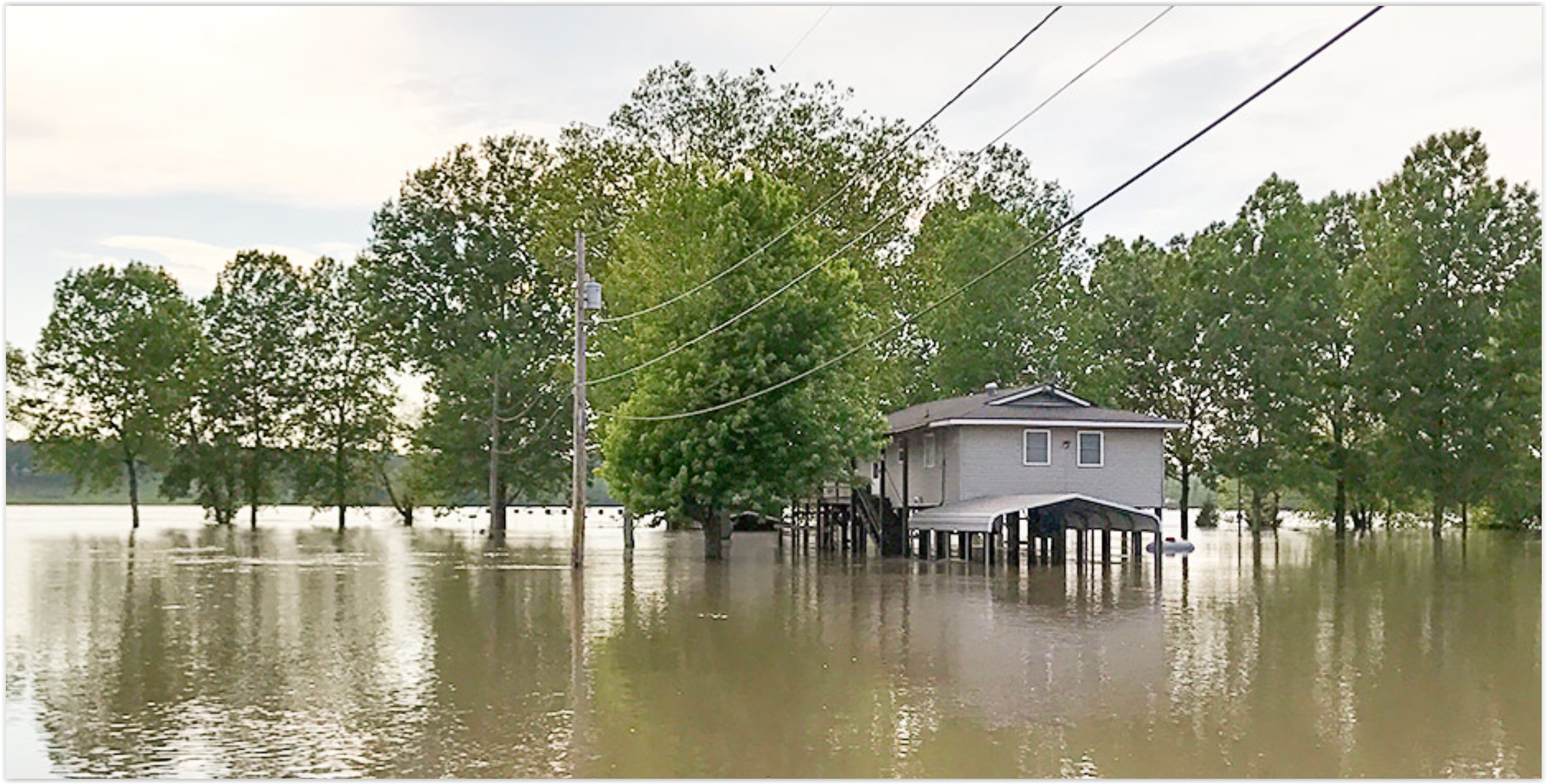 Trump Country is Flooding, and Climate Ideas Are Shifting. E&ENews
Trump Country is Flooding, and Climate Ideas Are Shifting. E&ENews
has an eye-opening article focused on changes being witnessed in the
Mississippi River Valley: "...
The politics of climate change make it
challenging for mayors south of St. Louis to discuss it openly, said
Colin Wellenkamp, executive director of the Mississippi River Cities and
Towns Initiative. They talk about disaster mitigation or disaster
resilience — often code words for how they're responding to climate
change without saying the words. Counts and other mayors understand that
disasters are on the rise, though. Counts laughs when Wellenkamp is
asked whether there's such a thing as a 100-year flood anymore.
Wellenkamp trots out familiar statistics: Since 2011, the
10-state Mississippi River corridor has seen $50 billion in natural
disaster impacts, including a 100-year flood, a 200-year flood, a
500-year flood, a 50-year drought and two hurricanes. The 75
cities in his network are learning how to live with the river,
Wellenkamp said, "not make the river live with us." "Our focus has been:
How do we really increase the number of solutions that are on the
table?" he said. "And how many of those solutions can work in the long
term?..."
Image credit: "
A flooded home on stilts near Thebes, Ill."
Photo by Erika Bolstad.
Data Drive to Help Farmers Cope With Climate Change Via Their Smartphones. Reuters explains: "As
smartphones spread to rural areas, an initiative backed by tech giants
aims to help small farmers in poor countries access data on crops,
weather and soil, helping them boost production in the face of climate
change, a farming group said on Monday.
Global agricultural research organization CGIAR said it joined forces
with tech firms including IBM and Amazon to analyze vast amounts of
agricultural data and advise farmers on the best production methods for
them. "It's time for smallholder farmers
to stop looking at the sky and praying for rain," said Andy Jarvis, a
research director at the International Center for Tropical Agriculture
(CIAT), which is part of CGIAR. "With enough data and enough analysts we'll be able to say if the rains will be late or on-time," he said in a statement..."
Climate Change: Extreme Rainfall Will Vary Between Regions. Here's an excerpt of a story summarizing new research at ScienceDaily: "A
new study by researchers from MIT and the Swiss Federal Institute of
Technology in Zurich shows that the most extreme rain events in most
regions of the world will increase in intensity by 3 to 15 percent,
depending on region, for every degree Celsius that the planet warms. If
global average temperatures rise by 4 degrees Celsius over the next
hundred years, as many climate models predict given relatively high CO2
emissions, much of North America and Europe would experience increases
in the intensity of extreme rainfall of roughly 25 percent. Some places
such as parts of the Asian monsoon region would experience greater
increases, while there will be smaller increases in the Mediterranean,
South Africa and Australia..."
 Managing Risk in a Changing Climate. WPSU-TV at Penn State has a description and link to the documentary: "Climate
change poses real threats that call for tough choices under deep
uncertainty. Louisiana has been called “the canary in the coal mine” for
climate impacts as it reports rates of relative sea level rise among
the highest in the world as more and more land disappears into the Gulf
of Mexico. The public television documentary Managing Risk in a Changing
Climate examines how Louisiana decision makers engage with researchers
and stakeholders to inform choices about how to manage risks driven by
changing sea levels and storms. Featuring some of the nation’s leading
climate experts and narrated by Peter Coyote, Managing Risk in a
Changing Climate examines one of humanity’s most pressing challenges
through the lens of the many academic disciplines needed to address the
impacts and surrounding economic, social, and environmental issues that
come with managing risk in a changing climate
Managing Risk in a Changing Climate. WPSU-TV at Penn State has a description and link to the documentary: "Climate
change poses real threats that call for tough choices under deep
uncertainty. Louisiana has been called “the canary in the coal mine” for
climate impacts as it reports rates of relative sea level rise among
the highest in the world as more and more land disappears into the Gulf
of Mexico. The public television documentary Managing Risk in a Changing
Climate examines how Louisiana decision makers engage with researchers
and stakeholders to inform choices about how to manage risks driven by
changing sea levels and storms. Featuring some of the nation’s leading
climate experts and narrated by Peter Coyote, Managing Risk in a
Changing Climate examines one of humanity’s most pressing challenges
through the lens of the many academic disciplines needed to address the
impacts and surrounding economic, social, and environmental issues that
come with managing risk in a changing climate..."
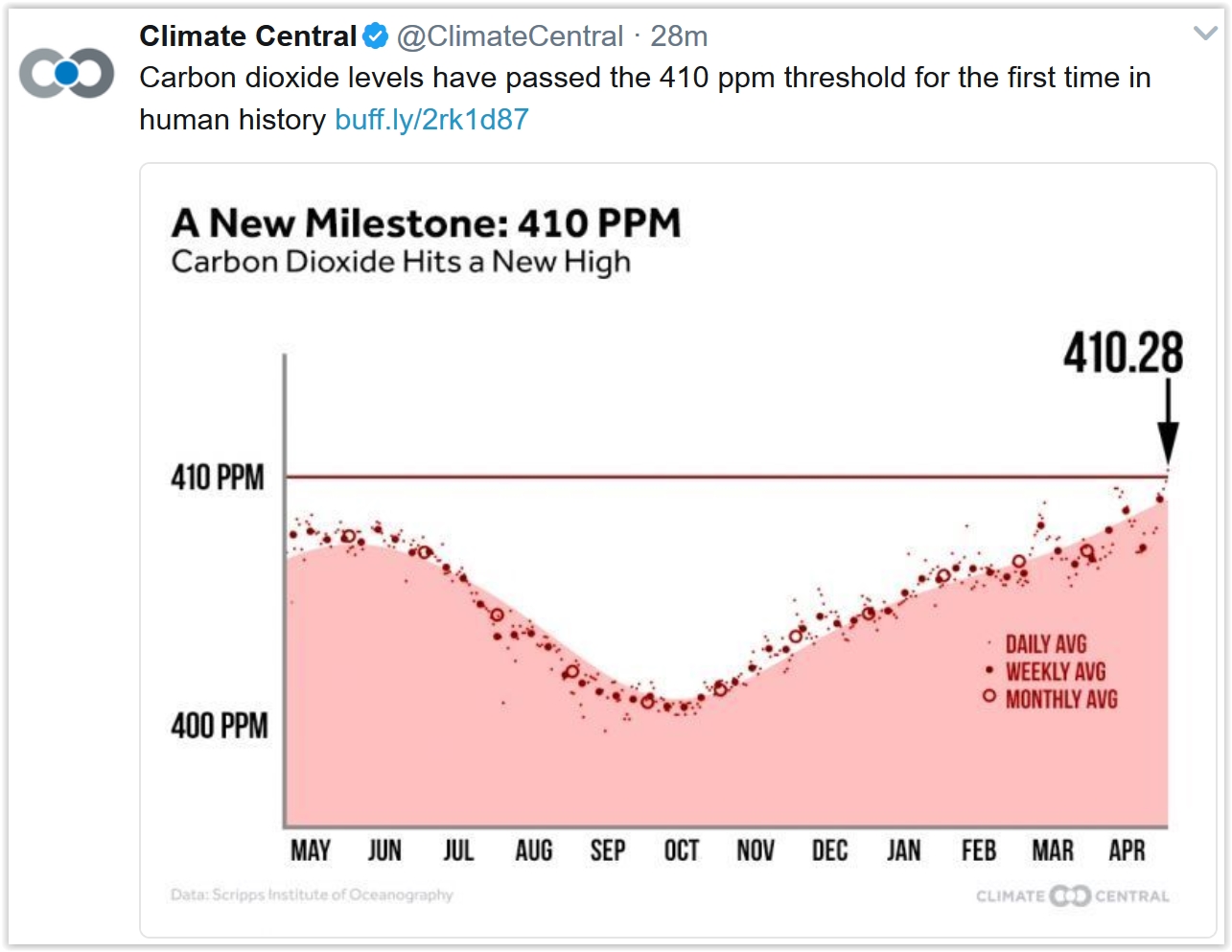
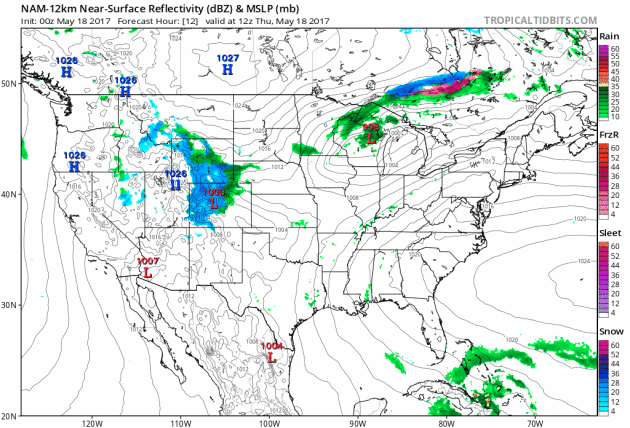


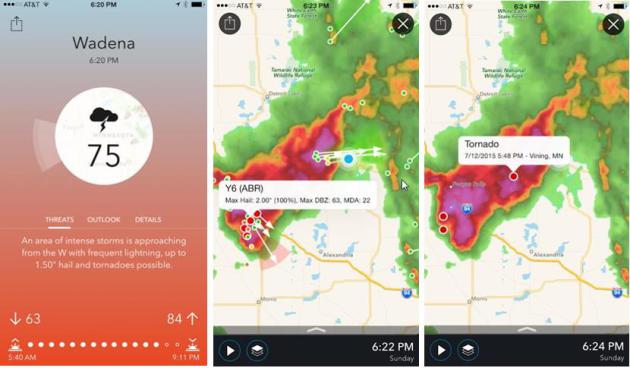
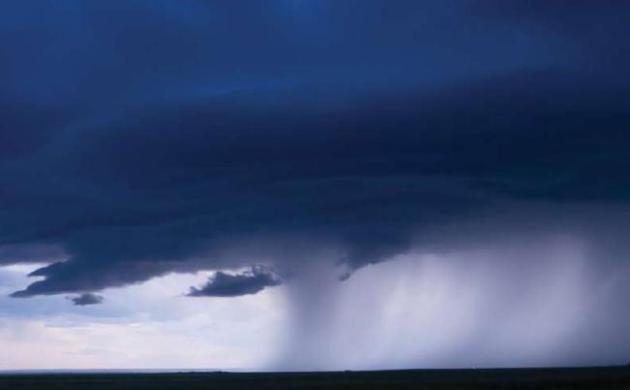
No comments:
Post a Comment